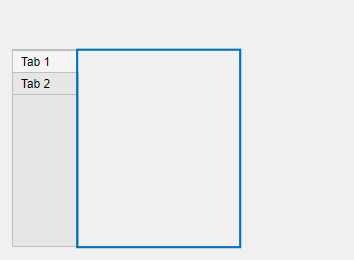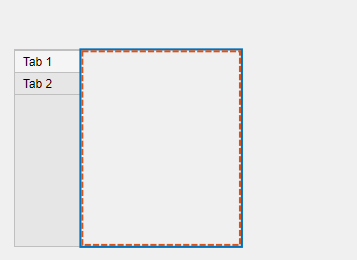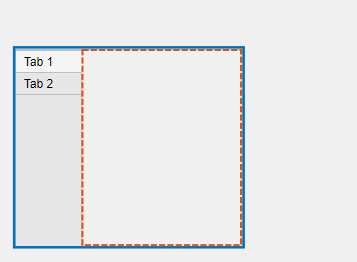Tab
选项卡 UI 容器
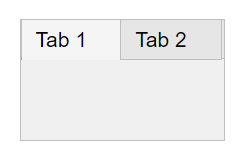
说明
选项卡 UI 容器将具有选项卡式标签的 UI 组件组合到一个选项卡组内。在创建选项卡后,使用 Tab 对象修改其外观和行为。
创建对象
使用 uitab 函数在 App 中创建一个选项卡。
属性
标题和颜色
标题,指定为字符向量、字符串标量或分类数组。如果将此属性指定为分类数组,MATLAB® 将仅显示数组中的第一个元素。
MATLAB 不会将竖线 ('|') 字符解释为换行符,它在标题中显示为竖线。
如果要指定 Unicode® 字符,则将 Unicode 十进制码传递到 char 函数。例如,['Multiples of ' char(960)] 显示为 Multiples of π。
标题颜色,指定为 RGB 三元组、十六进制颜色代码或下表中列出的颜色选项之一。
RGB 三元组和十六进制颜色代码对于指定自定义颜色非常有用。
RGB 三元组是包含三个元素的行向量,其元素分别指定颜色中红、绿、蓝分量的强度。强度值必须位于
[0,1]范围内,例如[0.4 0.6 0.7]。十六进制颜色代码是字符向量或字符串标量,以井号 (
#) 开头,后跟三个或六个十六进制数字,范围可以是0到F。这些值不区分大小写。因此,颜色代码"#FF8800"与"#ff8800"、"#F80"与"#f80"是等效的。
此外,还可以按名称指定一些常见的颜色。下表列出了命名颜色选项、等效 RGB 三元组和十六进制颜色代码。
| 颜色名称 | 短名称 | RGB 三元组 | 十六进制颜色代码 | 外观 |
|---|---|---|---|---|
"red" | "r" | [1 0 0] | "#FF0000" |
|
"green" | "g" | [0 1 0] | "#00FF00" |
|
"blue" | "b" | [0 0 1] | "#0000FF" |
|
"cyan" | "c" | [0 1 1] | "#00FFFF" |
|
"magenta" | "m" | [1 0 1] | "#FF00FF" |
|
"yellow" | "y" | [1 1 0] | "#FFFF00" |
|
"black" | "k" | [0 0 0] | "#000000" |
|
"white" | "w" | [1 1 1] | "#FFFFFF" |
|
下表列出了浅色和深色主题中绘图的默认调色板。
| 调色板 | 调色板颜色 |
|---|---|
在 R2025a 之前的版本中: 大多数绘图默认使用这些颜色。 |
|
|
|
您可以使用 orderedcolors 和 rgb2hex 函数获取这些调色板的 RGB 三元组和十六进制颜色代码。例如,获取 "gem" 调色板的 RGB 三元组并将其转换为十六进制颜色代码。
RGB = orderedcolors("gem");
H = rgb2hex(RGB);在 R2023b 之前的版本中: 使用 RGB = get(groot,"FactoryAxesColorOrder") 获取 RGB 三元组。
在 R2024a 之前的版本中: 使用 H = compose("#%02X%02X%02X",round(RGB*255)) 获取十六进制颜色代码。
背景颜色,指定为 RGB 三元组、十六进制颜色代码或下表中列出的颜色选项之一。
RGB 三元组和十六进制颜色代码对于指定自定义颜色非常有用。
RGB 三元组是包含三个元素的行向量,其元素分别指定颜色中红、绿、蓝分量的强度。强度值必须位于
[0,1]范围内,例如[0.4 0.6 0.7]。十六进制颜色代码是字符向量或字符串标量,以井号 (
#) 开头,后跟三个或六个十六进制数字,范围可以是0到F。这些值不区分大小写。因此,颜色代码"#FF8800"与"#ff8800"、"#F80"与"#f80"是等效的。
此外,还可以按名称指定一些常见的颜色。下表列出了命名颜色选项、等效 RGB 三元组和十六进制颜色代码。
| 颜色名称 | 短名称 | RGB 三元组 | 十六进制颜色代码 | 外观 |
|---|---|---|---|---|
"red" | "r" | [1 0 0] | "#FF0000" |
|
"green" | "g" | [0 1 0] | "#00FF00" |
|
"blue" | "b" | [0 0 1] | "#0000FF" |
|
"cyan" | "c" | [0 1 1] | "#00FFFF" |
|
"magenta" | "m" | [1 0 1] | "#FF00FF" |
|
"yellow" | "y" | [1 1 0] | "#FFFF00" |
|
"black" | "k" | [0 0 0] | "#000000" |
|
"white" | "w" | [1 1 1] | "#FFFFFF" |
|
下表列出了浅色和深色主题中绘图的默认调色板。
| 调色板 | 调色板颜色 |
|---|---|
在 R2025a 之前的版本中: 大多数绘图默认使用这些颜色。 |
|
|
|
您可以使用 orderedcolors 和 rgb2hex 函数获取这些调色板的 RGB 三元组和十六进制颜色代码。例如,获取 "gem" 调色板的 RGB 三元组并将其转换为十六进制颜色代码。
RGB = orderedcolors("gem");
H = rgb2hex(RGB);在 R2023b 之前的版本中: 使用 RGB = get(groot,"FactoryAxesColorOrder") 获取 RGB 三元组。
在 R2024a 之前的版本中: 使用 H = compose("#%02X%02X%02X",round(RGB*255)) 获取十六进制颜色代码。
交互性
滚动能力,指定为 'off' 或 'on',或者指定为数值或逻辑值 1 (true) 或 0 (false)。值 'on' 等效于 true,'off' 等效于 false。因此,您可以使用此属性的值作为逻辑值。该值存储为 matlab.lang.OnOffSwitchState 类型的 on/off 逻辑值。
将此属性设置为 'on' 可以在容器内滚动。但是,还有其他要求:
容器中子组件占用的区域必须大于容器一次可显示的区域。
在容器内无法容纳的组件必须位于容器的上方或右侧。您不能滚动到容器下方或左侧的组件。
如果容器包含网格布局管理器,则容器的
Scrollable属性不起作用。要启用滚动,请改为将GridLayout对象的Scrollable属性设置为'on'。
某些类型的图和坐标区不支持可滚动容器。但是,您可以将图或坐标区放在不可滚动的面板中,然后将该面板放在可滚动的容器中。有关详细信息,请参阅在 App 设计工具中显示图形。
工具提示,指定为字符向量、字符串标量、字符向量元胞数组、字符串数组或一维分类数组。如果使用此属性,则在运行时当用户将指针悬停在组件上时,将显示消息。要显示多行文本,请指定字符向量元胞数组或字符串数组。数组中的每个元素变为一行文本。如果将此属性指定为分类数组,MATLAB 将使用数组中的值,而不是完整的类别集。
上下文菜单,指定为使用 uicontextmenu 函数创建的 ContextMenu 对象。使用此属性可在您右键点击组件时显示上下文菜单。
位置
此 属性 为只读。
选项卡的位置和大小,返回为 [left bottom width height] 形式的四元素向量。此表介绍该向量中的每个元素。
| 元素 | 描述 |
|---|---|
left | 选项卡组的内部左边缘与选项卡的内部左边缘之间的距离 |
bottom | 选项卡组的内部下边缘与选项卡的内部下边缘之间的距离 |
width | 选项卡的左右内部边缘之间的距离 |
height | 选项卡的上下内部边缘之间的距离 |
所有测量值都采用 Units 属性指定的单位。
注意
以下是使用 Position 属性时要注意的一些重要内容:
Position值受到选项卡标题的长度和父TabGroup对象的TabLocation属性的影响。Position值相对于父TabGroup的可绘制区域,即边框内的区域。如果选项卡位于网格布局管理器中,则
Position属性的值不会立即更新。要使用Position值相对于选项卡大小调整选项卡子级的大小,请使用SizeChangedFcn回调。
此 属性 为只读。
选项卡的位置和大小,返回为 [left bottom width height] 形式的四元素向量。所有测量值都采用 Units 属性指定的单位。
此属性值等同于 Position 和 OuterPosition 属性值。
此 属性 为只读。
选项卡的位置和大小,返回为 [left bottom width height] 形式的四元素向量。所有测量值都采用 Units 属性指定的单位。
此属性值等同于 Position 和 InnerPosition 属性值。
测量单位,指定为下表中的值之一。
| 单位值 | 描述 |
|---|---|
'pixels'(基于 uifigure 的 App 中的默认值) | 在 Windows® 和 Macintosh 系统上,像素的大小为 1/96 英寸。此大小与系统分辨率无关。 在 Linux® 系统上,一个像素的大小由系统分辨率确定。 |
'normalized'(基于 figure 的 App 中的默认值) | 这些单位依据父容器进行归一化。容器的左下角映射到 |
'inches' | 英寸。 |
'centimeters' | 厘米。 |
'points' | 磅。1 磅等于 1/72 英寸。 |
'characters' | 这些单位基于图形根对象的默认 uicontrol 字体:
要访问默认的 uicontrol 字体,请使用 |
推荐值为 'pixels',因为大多数 MATLAB App 构建功能都以像素为单位测量距离。您可以创建一个对象,该对象根据父容器的大小重新缩放,方法是将使用 uigridlayout 函数创建的一个网格布局管理器作为该对象的父级。有关详细信息,请参阅Lay Out Apps Programmatically。
自动调整子组件的大小,指定为 'on' 或 'off',或者指定为数值或逻辑值 1 (true) 或 0 (false)。值 'on' 等效于 true,'off' 等效于 false。因此,您可以使用此属性的值作为逻辑值。该值存储为 matlab.lang.OnOffSwitchState 类型的 on/off 逻辑值。
'on'- 当容器调整大小时,子组件会自动调整大小。此值是使用uifigure函数创建的图窗中选项卡的默认值。'off'- 子组件不调整大小。此值是使用figure函数创建的图窗中选项卡的默认值。
AutoResizeChildren 属性影响容器的直接子组件,而不影响嵌套容器内的子组件。
当 AutoResizeChildren 为 'on' 时,某些子组件不会自动调整大小。例如,仅包含非调整大小组件的标签、按钮和容器不会调整大小。
要自定义调整大小行为,请向容器添加网格布局管理器,或将 AutoResizeChildren 属性设置为 'off' 并为容器创建一个 SizeChangedFcn 回调。有关详细信息,请参阅在 App 设计工具中管理可调整大小的 App。
要禁用 App 的大小调整,请将图窗的 Resize 属性设置为 'off'。
建议仅在以像素为单位进行布局的 App 中将 AutoResizeChildren 指定为 'on'。在不以像素为单位进行布局的 App 中启用自动调整大小可能导致意外行为。
回调
更改大小时执行的回调,指定为下列值之一:
函数句柄。
第一个元素是函数句柄的元胞数组。元胞数组中的后续元素是传递到回调函数的参量。
包含有效 MATLAB 表达式的字符向量(不推荐)。MATLAB 在基础工作区计算此表达式。
定义此回调在此容器的大小更改时(例如,当用户调整窗口大小时)自定义 App 布局。
注意
除非此容器的 AutoResizeChildren 属性设置为 'off',否则 SizeChangedFcn 回调将不会执行。在 App 设计工具中,您可以通过在 UI 图窗属性面板中清除 AutoResizeChildren 复选框来使 SizeChangedFcn 可执行。
当父选项卡组容器出现下列情况时执行 SizeChangedFcn:
该容器首次变得可见。
该容器在大小改变时可见。
该容器在大小改变后首次变得可见。如果容器在大小改变时不可见,但后来变得可见,就属于这种情况。
定义 SizeChangedFcn 回调时要考虑的其他重要事项:
考虑将此容器推迟到
SizeChangedFcn使用的所有变量都定义之后再显示。此做法可避免SizeChangedFcn回调返回错误。要实现这种延迟,可以通过将父选项卡组容器的Visible属性设置为'off'来延迟该容器的显示。然后,在定义您的SizeChangedFcn回调使用的变量之后将Visible属性设置为'on'。如果您的 App 包含嵌套容器,它们从里向外调整大小。
要访问通过
SizeChangedFcn调整大小的容器,请指向源对象(回调中的第一个输入参量)。
指定调整大小行为的替代方法是创建 GridLayout 对象或使用 App 设计工具中的自动调整布局选项。这些选项比 SizeChangedFcn 回调更容易使用。然而,与这些选项相比,SizeChangedFcn 回调有一些优势。例如:
将组件调整到您定义的最小或最大大小。
实现非线性调整大小行为。
按下鼠标按键回调函数,指定为下列值之一:
函数句柄。
第一个元素是函数句柄的元胞数组。元胞数组中的后续元素是传递到回调函数的参量。
包含有效 MATLAB 表达式的字符向量(不推荐)。MATLAB 在基础工作区计算此表达式。
有关将回调属性值指定为函数句柄、元胞数组或字符向量的详细信息,请参阅Specify a Callback Function。
ButtonDownFcn 回调是当用户在容器内点击鼠标按键时执行的函数。
对象创建函数,指定为下列值之一:
函数句柄。
第一个元素是函数句柄的元胞数组。元胞数组中的后续元素是传递到回调函数的参量。
包含有效 MATLAB 表达式的字符向量(不推荐)。MATLAB 在基础工作区计算此表达式。
有关将回调指定为函数句柄、元胞数组或字符向量的详细信息,请参阅App 设计工具中的回调。
此属性指定要在 MATLAB 创建对象时执行的回调函数。MATLAB 将在执行 CreateFcn 回调之前初始化所有属性值。如果不指定 CreateFcn 属性,则 MATLAB 执行默认的创建函数。
对现有组件设置 CreateFcn 属性没有任何作用。
如果将此属性指定为函数句柄或元胞数组,则可以使用回调函数的第一个参量访问正在创建的对象。否则,使用 gcbo 函数访问该对象。
对象删除函数,指定为下列值之一:
函数句柄。
第一个元素是函数句柄的元胞数组。元胞数组中的后续元素是传递到回调函数的参量。
包含有效 MATLAB 表达式的字符向量(不推荐)。MATLAB 在基础工作区计算此表达式。
有关将回调指定为函数句柄、元胞数组或字符向量的详细信息,请参阅App 设计工具中的回调。
此属性指定在 MATLAB 删除对象时要执行的回调函数。MATLAB 在销毁对象的属性之前执行 DeleteFcn 回调。如果不指定 DeleteFcn 属性,则 MATLAB 执行默认的删除函数。
如果将此属性指定为函数句柄或元胞数组,则可以使用回调函数的第一个参量访问要删除的对象。否则,使用 gcbo 函数访问该对象。
回调执行控件
回调中断,指定为 'on' 或 'off',或者指定为数值或逻辑值 1 (true) 或 0 (false)。值 'on' 等效于 true,'off' 等效于 false。因此,您可以使用此属性的值作为逻辑值。该值存储为 matlab.lang.OnOffSwitchState 类型的 on/off 逻辑值。
此属性确定是否可以中断运行中回调。有以下两种回调状态要考虑:
运行中回调是当前正在执行的回调。
中断回调是试图中断运行中回调的回调。
每次执行处理回调队列的命令时,MATLAB 都会确定回调中断行为。这些命令包括 drawnow、figure、uifigure、getframe、waitfor 和 pause。
如果运行中回调不包含上述命令之一,则不会发生中断。MATLAB 首先完成执行运行中回调,然后执行中断回调。
如果运行中回调确实包含上述命令之一,则由运行中回调所属对象的 Interruptible 属性来确定是否发生中断:
如果
Interruptible的值为'off',则不会发生中断。此时,由中断回调所属对象的BusyAction属性确定中断回调是被丢弃还是添加到回调队列中。如果
Interruptible的值为'on',则发生中断。下次 MATLAB 处理回调队列时,它会停止运行中回调的执行,并执行中断回调。在中断回调完成后,MATLAB 将继续执行运行中回调。
注意
回调的中断和执行在以下情况下会有不同的表现:
如果中断回调是
DeleteFcn、CloseRequestFcn或SizeChangedFcn回调,则无论是否存在Interruptible属性值都会发生中断。如果运行中回调当前正在执行
waitfor函数,则无论是否存在Interruptible属性值都会发生中断。如果中断回调由
Timer对象所有,则回调将根据调度执行,而不考虑Interruptible属性值。
回调排队,指定为 'queue' 或 'cancel'。BusyAction 属性决定 MATLAB 如何处理中断回调的执行。有以下两种回调状态要考虑:
运行中回调是当前正在执行的回调。
中断回调是试图中断运行中回调的回调。
BusyAction 属性仅在同时满足以下两个条件时才确定回调排队行为:
在这些情况下,由中断回调所属对象的 BusyAction 属性确定 MATLAB 如何处理中断回调。以下是 BusyAction 属性的可能值:
'queue'- 将中断回调放入队列中,以便在运行中回调执行完毕后进行处理。'cancel'- 不执行中断回调。
此 属性 为只读。
删除状态,以 matlab.lang.OnOffSwitchState 类型的 on/off 逻辑值形式返回。
当 DeleteFcn 回调开始执行时,MATLAB 会将 BeingDeleted 属性设置为 'on'。BeingDeleted 属性将一直保持 'on' 设置状态,直到组件对象不再存在为止。
在查询或修改对象之前,请先检查其 BeingDeleted 属性的值,以确认它不是待删除项。
父级/子级
父对象,指定为 TabGroup 对象。
选项卡的子级,以空 GraphicsPlaceholder 或 App 组件对象的一维数组形式返回。
不能使用选项卡的 Children 属性添加或删除子级。使用该属性查看子级列表或对子级重新排序。子级在该数组中的顺序反映了显示在屏幕上的选项卡的顺序。
要向该列表中添加子级,请将子组件的 Parent 属性设置为 Tab 对象。
对象句柄的可见性,指定为 'on'、'callback' 或 'off'。
此属性控制对象在其父级的子级列表中的可见性。当对象未显示在其父级的子级列表中时,通过搜索对象层次结构或查询属性来获取对象的函数不会返回该对象。这些函数包括 get、findobj、clf 和 close。对象即使在不可见时也有效。如果可以访问某个对象,则可以设置和获取其属性,并将其传递给针对对象进行运算的任意函数。
| HandleVisibility 值 | 描述 |
|---|---|
'on' | 对象始终可见。 |
'callback' | 对象对于回调或回调调用的函数可见,但对于命令行调用的函数不可见。此选项阻止通过命令行访问对象,但允许回调函数访问它。 |
'off' | 对象始终不可见。该选项用于防止另一函数无意中对 UI 进行更改。将 HandleVisibility 设置为 'off' 可在执行该函数时暂时隐藏对象。 |
标识符
此 属性 为只读。
图形对象的类型,以 'uitab' 形式返回。
对象标识符,指定为字符向量或字符串标量。您可以指定唯一的 Tag 值作为对象的标识符。如果需要访问您代码中其他位置的对象,可以使用 findobj 函数基于 Tag 值搜索对象。
用户数据,指定为任何 MATLAB 数组。例如,您可以指定标量、向量、矩阵、元胞数组、字符数组、表或结构体。使用此属性存储对象上的任意数据。
如果您在 App 设计工具中工作,请在该 App 中创建公共或私有属性以共享数据,而不是使用 UserData 属性。有关详细信息,请参阅在用 App 设计工具创建的 App 内共享数据。
对象函数
scroll | 滚动到 UI 组件内的位置 |
isInScrollView | Determine if component is visible in scrollable container |
示例
在 UI 图窗中创建一个具有两个选项卡的选项卡组,并通过指定属性值来自定义选项卡的外观。
fig = uifigure; tg = uitabgroup(fig); t1 = uitab(tg,"Title","Data","BackgroundColor",[0 0.4470 0.7410]); t2 = uitab(tg,"Title","Plots","BackgroundColor",[0 0.4470 0.7410]);
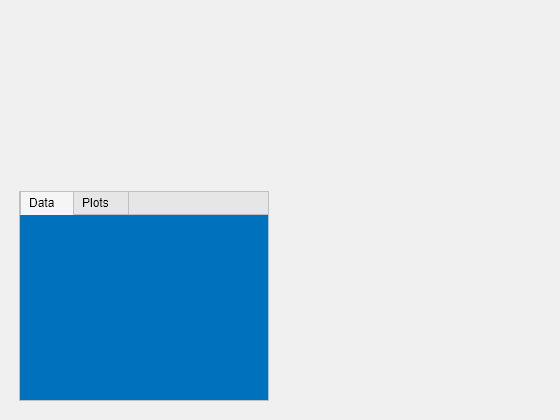
查询 Data 选项卡标题的文本颜色。
c = t1.ForegroundColor
c = 1×3
0.1294 0.1294 0.1294
更新文本颜色以匹配选项卡背景颜色。
t1.ForegroundColor = t1.BackgroundColor;

创建包含一个选项卡的选项卡组。向该选项卡添加六个 UI 组件,前三个组件位于选项卡的上边框的外部。
fig = uifigure; tg = uitabgroup(fig,'Position',[20 20 196 145]); t = uitab(tg,'Title','Member Information'); ef1 = uieditfield(t,'text','Position',[11 165 140 22],'Value','First Name'); ef2 = uieditfield(t,'text','Position',[11 140 140 22],'Value','Last Name'); ef3 = uieditfield(t,'text','Position',[11 115 140 22],'Value','Address'); dd = uidropdown(t,'Position',[11 90 140 22],'Items',{'Male','Female'}); cb = uicheckbox(t,'Position',[11 65 140 22],'Text','Member'); b = uibutton(t,'Position',[11 40 140 22],'Text','Send');

通过将选项卡的 Scrollable 属性设置为 'on' 来启用滚动。默认情况下,滚动框显示在顶部。
t.Scrollable = 'on';
在新脚本中,在 UI 图窗中创建一个具有两个选项卡的选项卡组。将 SelectionChangedFcn 属性指定为名为 displaySelection 的函数的句柄。当用户在选项卡组中的选项卡之间切换时,将执行此函数。
在脚本的底部,定义 displaySelection 函数来接受 MATLAB 传递给回调函数的两个输入参量:
src- 执行回调的组件event- 关于触发回调的用户交互的信息
在回调函数中,编写代码以在命令行窗口中显示可见选项卡的标题。
fig = uifigure; tg = uitabgroup(fig,"SelectionChangedFcn",@displaySelection); t1 = uitab(tg,"Title","Data"); t2 = uitab(tg,"Title","Plots"); function displaySelection(src,event) t = event.NewValue; title = t.Title; disp("Viewing the " + title + " tab") end
运行脚本并在选项卡之间切换以显示选项卡标题。
有关详细信息,请参阅Create Callbacks for Apps Created Programmatically。
版本历史记录
在 R2014b 中推出这些属性可用于使用 figure 函数创建的 App 中的选项卡:
ScrollableAutoResizeChildren
对于使用 figure 函数创建的 App,当您查询选项卡组的 InnerPosition 属性时,该属性将返回与上一版本不同的值。此外,如果 TabLocation 是 'left' 或 'bottom',当您查询选项卡组中某个选项卡的 Position、InnerPosition 和 OuterPosition 属性时,这些属性可能会返回与以前版本不同值。这些更改使属性值和行为与基于 uifigure 的 App 中的属性一致。
下表描述 R2025a 及更早版本的属性值之间的差异。
| 属性 | 从 R2025a 开始 | R2024b 及更早版本 | ||
|---|---|---|---|---|
| 描述 | 图像 | 描述 | 图像 | |
选项卡组的 InnerPosition | 形式为 [left bottom width height] 的四元素向量,表示选项卡组相对于其父级的可绘制区域的大小和位置,不包括其中包含的选项卡的边框和标题 | 选项卡组
| 形式为 [left bottom width height] 的四元素向量,表示选项卡组相对于其父级的可绘制区域的大小和位置,包括其中所包含的选项卡的边框和标题 | 选项卡组
|
选项卡的 Position、InnerPosition 和 OuterPosition | 形式为 [left bottom width height] 的四元素向量,表示选项卡相对于选项卡组可绘制区域的大小和位置,其中选项卡组可绘制区域不包括边框和标题 | 相对于选项卡组可绘制区域(蓝色实线)的选项卡
| 形式为 [left bottom width height] 的四元素向量,表示选项卡相对于选项卡组可绘制区域的大小和位置,其中选项卡组可绘制区域包括边框和标题 | 相对于选项卡组可绘制区域(蓝色实线)的选项卡
|
如果您注意到 App 布局的变化,请考虑以下列方式更新您的代码:
选项卡组
InnerPosition- 用选项卡组Position属性替换对选项卡组InnerPosition属性的引用,以使用选项卡组的大小和位置,包括边框和选项卡标题。选项卡
Position、InnerPosition和OuterPosition- 替换对位置向量的前两个元素的引用,以使用选项卡标题在左侧或底部占据的空间。例如,如果您的 App 包含TabLocation值为'left'的选项卡组,并且您引用该选项卡组中某个选项卡的Position属性,请将该引用替换为选项卡组边框和选项卡可绘制区域之间的水平距离。
对于在 App 设计工具中创建并使用 uifigure 函数的 App,当您查询选项卡组的 InnerPosition 属性时,该属性将返回与以前版本不同值。此外,如果 TabLocation 是 'left' 或 'bottom',当您查询选项卡组中某个选项卡的 Position、InnerPosition 和 OuterPosition 属性时,这些属性可能会返回与以前版本不同值。
下表描述 R2022b 及更早版本的属性值之间的差异。
| 属性 | 从 R2022b 开始 | R2022a 及更早版本 | ||
|---|---|---|---|---|
| 描述 | 图像 | 描述 | 图像 | |
选项卡组的 InnerPosition | 形式为 [left bottom width height] 的四元素向量,表示选项卡组相对于其父级的可绘制区域的大小和位置,不包括其中包含的选项卡的边框和标题 | 选项卡组
| 形式为 [left bottom width height] 的四元素向量,表示选项卡组相对于其父级的可绘制区域的大小和位置,包括其中所包含的选项卡的边框和标题 | 选项卡组
|
选项卡的 Position、InnerPosition 和 OuterPosition | 形式为 [left bottom width height] 的四元素向量,表示选项卡相对于选项卡组可绘制区域的大小和位置,其中选项卡组可绘制区域不包括边框和标题 | 相对于选项卡组可绘制区域(蓝色实线)的选项卡
| 形式为 [left bottom width height] 的四元素向量,表示选项卡相对于选项卡组可绘制区域的大小和位置,其中选项卡组可绘制区域包括边框和标题 | 相对于选项卡组可绘制区域(蓝色实线)的选项卡
|
如果您注意到 App 布局的变化,请考虑以下列方式更新您的代码:
选项卡组
InnerPosition- 用选项卡组Position属性替换对选项卡组InnerPosition属性的引用,以使用选项卡组的大小和位置,包括边框和选项卡标题。选项卡
Position、InnerPosition和OuterPosition- 替换对位置向量的前两个元素的引用,以使用选项卡标题在左侧或底部占据的空间。例如,如果您的 App 包含TabLocation值为'left'的选项卡组,并且您引用该选项卡组中某个选项卡的Position属性,请将该引用替换为选项卡组边框和选项卡可绘制区域之间的水平距离。
从 R2020a 开始,不推荐使用 UIContextMenu 属性将上下文菜单分配给图形对象或 UI 组件。请改用 ContextMenu 属性。属性值是相同的。
目前没有停止支持 UIContextMenu 属性的计划。但是,UIContextMenu 属性将不再出现在对图形对象或 UI 组件调用 get 函数时所返回的列表中。
从 R2018b 开始,不推荐使用 TooltipString 属性为 UI 组件指定工具提示。请改用 Tooltip 属性。属性值是相同的。
目前没有停止支持 TooltipString 属性的计划。但是,TooltipString 属性将不再出现在对 UI 组件调用 get 函数时所返回的列表中。
MATLAB Command
You clicked a link that corresponds to this MATLAB command:
Run the command by entering it in the MATLAB Command Window. Web browsers do not support MATLAB commands.
选择网站
选择网站以获取翻译的可用内容,以及查看当地活动和优惠。根据您的位置,我们建议您选择:。
您也可以从以下列表中选择网站:
如何获得最佳网站性能
选择中国网站(中文或英文)以获得最佳网站性能。其他 MathWorks 国家/地区网站并未针对您所在位置的访问进行优化。
美洲
- América Latina (Español)
- Canada (English)
- United States (English)
欧洲
- Belgium (English)
- Denmark (English)
- Deutschland (Deutsch)
- España (Español)
- Finland (English)
- France (Français)
- Ireland (English)
- Italia (Italiano)
- Luxembourg (English)
- Netherlands (English)
- Norway (English)
- Österreich (Deutsch)
- Portugal (English)
- Sweden (English)
- Switzerland
- United Kingdom (English)










